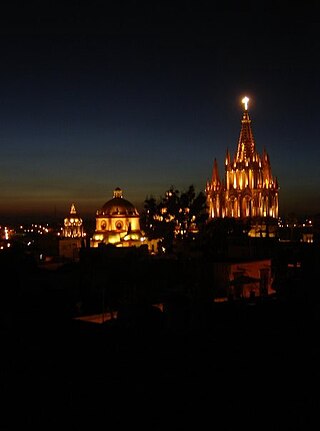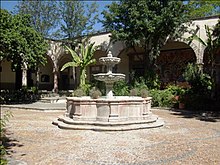
David Alfaro Siqueiros was a Mexican social realist painter, best known for his large public murals using the latest in equipment, materials and technique. Along with Diego Rivera and José Clemente Orozco, he was one of the most famous of the "Mexican muralists".

Guanajuato, officially the Free and Sovereign State of Guanajuato, is one of the 32 states that make up the Federal Entities of Mexico. It is divided into 46 municipalities and its capital city is Guanajuato.

San Miguel de Allende is the principal city in the municipality of San Miguel de Allende, located in the far eastern part of Guanajuato, Mexico. A part of the Bajío region, the city lies 274 km (170 mi) from Mexico City, 86 km (53 mi) from Querétaro, and 97 km (60 mi) from the state capital of Guanajuato. The city's name derives from two persons: 16th-century friar Juan de San Miguel, and a martyr of Mexican Independence, Ignacio Allende, who was born in a house facing the city's central plaza. San Miguel de Allende was also a critical epicenter during the historic Chichimeca War (1540–1590) when the Chichimeca held back the Spanish Empire during the initial phases of European colonization. Today, an old section of the town is part of a proclaimed World Heritage Site, attracting thousands of tourists and new residents from abroad every year.
Leonard Brooks was a Canadian artist.

The Guanajuato International Film Festival or GIFF is an annual international film festival, held since 1998. It is held during the final week of July in San Miguel de Allende and Guanajuato City, Mexico. GIFF was formerly known as Expresión en Corto International Film Festival.

Romeo Villalva Tabuena was a Filipino painter and printmaker who was born in Iloilo City. He studied architecture at the Mapúa Institute of Technology in Manila and painting at the University of the Philippines. He also studied at the Art Students League of New York and at the Académie de la Grande Chaumière in Paris.

José Chávez Morado was a Mexican artist who was associated with the Mexican muralism movement of the 20th century. His generation followed that of Diego Rivera, José Clemente Orozco and David Alfaro Siqueiros. Although Chávez Morado took classes in California and Mexico, he is considered to be mostly self-taught. He experimented with various materials, and was an early user of Italian mosaic in monumental works. His major works include murals at the Ciudad Universitaria, Secretaría de Comunicaciones y Transportes and Museo Nacional de Antropología in Mexico City as well as frescos at the Alhóndiga de Granaditas, which took twelve years to paint. From the 1940s on, he also worked as a cultural promoter, establishing a number of cultural institutions especially in his home state of Guanajuato including the Museo de Arte Olga Costa - José Chávez Morado, named after himself and his wife, artist Olga Costa.
Luis Gutierrez is an American artist based in Los Gatos, California, USA.

Stirling Dickinson was an American artist who spent much of his life in San Miguel de Allende, Guanajuato in Mexico, where he was one of the first members of what would become a colony of expatriate artists from the United States and Canada.

Reva Brooks was a Canadian photographer who did much of her work in and around San Miguel de Allende in Mexico. The San Francisco Museum of Art chose Reva Brooks as one of the top 50 women photographers in history.

Gorky González Quiñones was a Mexican potter who won the Premio Nacional de Ciencias y Artes for his efforts to revive Mexican maiolica pottery. He began in the arts following his father, sculptor Rodolfo González. Although he worked with and studied ceramics in Mexico and Japan, he did not work with maiolica until he received two pieces as part of his antique business. The technique had almost died out in his region, and González Quiñones learned how to make them. His workshop was in Guanajuato, with a client base in Mexico and the United States.

Jesús Nicolás Cuéllar was a Mexican painter who was best known for his surreal and magically themed work as well as his mentorship of the artistic community in his hometown of San Miguel de Allende. Some of his early work was noticed by Diego Rivera, who declared that the artist would be "a monster of painting." Although he studied and exhibited abroad and his works can be found in collections in various parts of the world, Cuéllar dedicated most of his career in his studio in San Miguel de Allende.

Wynona Croft Mulcaster was a Canadian painter and teacher from Saskatchewan, best known for her prairie landscapes. She also played an important role in developing competitive riding in Saskatoon.

Felipe Cossío del Pomar was a Peruvian painter and left-wing political activist. While in exile from Peru he founded an art school in San Miguel de Allende in Mexico in 1938. The school failed, but on his return in 1950 he founded the Instituto Allende, a university-level arts school that was still active in 2014. The short film "Felipe Cossio del Pomar in San Miguel de Allende", by Ezequiel Morones is in Youtube.

Guanajuato handcrafts and folk art are mostly of European origin, although some indigenous work still survives in some communities. The most notable craft is the making of glazed mayolica pottery, followed by handmade traditional toys of various materials, especially a hard paper mache called cartonería. While handcrafts are not a large an industry here as in some other states, it does have several major handcraft markets which sell to tourists and foreign residents. Other handcraft traditions include wrought iron work, tin and glass, wood carving and leather working.

The Hacienda Santa Clara is a study abroad and research center located in San Miguel Allende, Guanajuato, Mexico. It is on a former maguey hacienda in central Mexico, which was reconstructed for the center in the 2010s, to support study abroad students and researchers, primarily from the United States.
Luis Merino is a Mexican/Canadian painter. His work can be found in numerous public and private collections in Canada, Mexico, and the United States. Some of his most notable work is on display in the Maltwood Art Museum and Gallery, at the University of Victoria in Greater Victoria, British Columbia, Canada.
San Miguel de Allende is a municipality of Guanajuato, Mexico, and is also part of the Bajío region. Its seat of government is located in the city of San Miguel de Allende, which is also the most populous settlement of the municipality.
Marisa Boullosa is a Mexican artist. She lives and works in San Miguel De Allende, Guanajuato, Mexico.

















